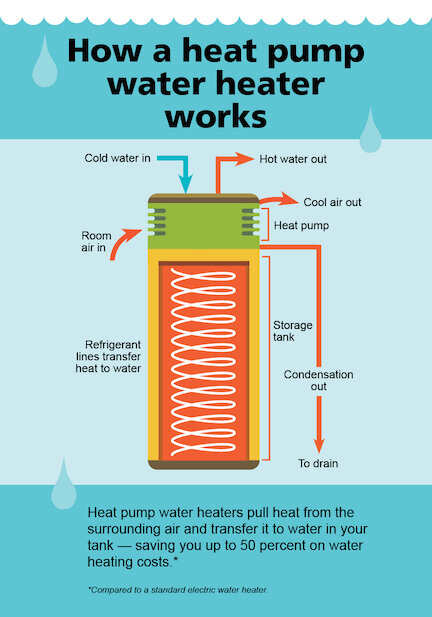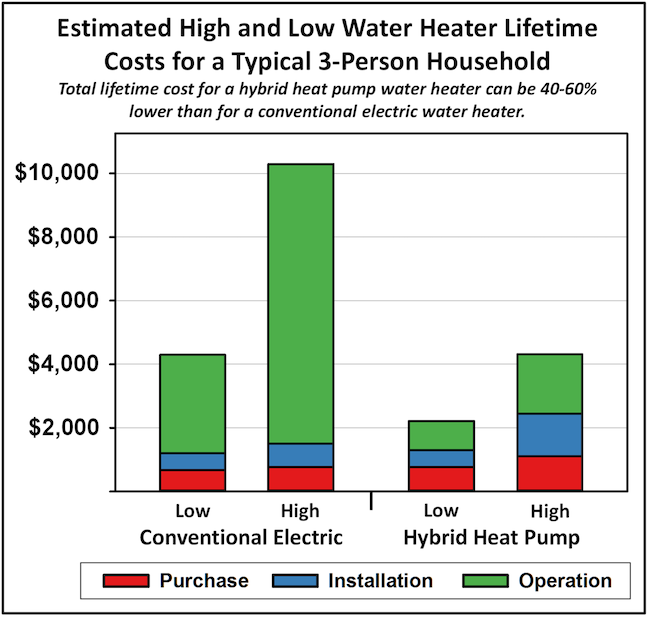Why Aren’t We Installing More Heat Pump Water Heaters?
Updated: Jan 10, 2023
As many of you know, heat pumps are a hot topic of conversation in the home energy performance industry. This is for good reason as heat pumps can be carbon neutral and have gotten more efficient and reliable over the past few decades. According to national averages, when homeowners make the switch from propane or oil to an electric heat pump, they typically find a dramatic reduction in their utility bills.* What’s more is that the emissions benefits are dramatic and climate policy will necessitate a rapid shift from natural gas over the next few decades.
Like refrigerators, heat pumps use electricity to move heat from a cool space to a warm space, making the cool space cooler and a warm space warmer. During the heating season, heat pumps move heat from the cool outdoors into your warm house and during the cooling season, heat pumps move heat from your cool house into the warm outdoors.
Most homeowners who have heat pumps use them to heat and cool their homes. But a heat pump can also be used to heat water -- either as a stand-alone water heating system, or as a combination water heating and space conditioning system. Heat pump water heaters (HPWH) are typically 2 to 3.5 times more energy efficient than conventional electric resistance water heaters.
A heat pump water heater can save a household of four people around $350 per year, according to the government website Energy Star, adding up to a savings of around $3,750 over the lifetime of a typical heat pump water heater.
Over 30 municipalities in California and Massachusetts have already passed policies prohibiting or strongly disincentivizing gas water heaters in new buildings. While HPWH systems have been sold in the U.S. for over 40 years, they’ve struggled to penetrate the market and gain share from traditional water heaters. When we took a look at our own data we found that out of over 200,000 homes rated in Ekotrope last year, only 2% had installed a HPWH.
Now, if heat pumps are one of the most cost effective ways to reduce energy consumption and emissions, why aren’t they more widely used? We chatted with Mike Ostiguy, Vice President of Operations at Abode Energy Management, about some of the issues and misconceptions associated with HPWHs as well as how we can help to solve them.
Price:
HPWHs are more expensive than most conventional water heaters. Including installation costs, a typical HPWH goes for around $3,000 while a conventional electric water heater is about $1,650.
But when considering the lifetime costs, HPWHs are a fantastic investment. With the typical savings of $330/yr, a HPWH would pay back in less than 5 years. That’s more than a 20% return on investment, which is WAY better than the average return of the stock market and a whole lot safer!
Climate:
While a heat-pump water heater will save significant energy on a year-round basis, it’s important to note that HPWHs perform better in warmer climates. Since they take heat from the surrounding air, when it’s cold outside, it requires the heating system to work harder. On the flip-side, when it’s hot, a HPWH provides ‘free’ cooling. HPWHs require installation in locations that remain in the 40º–90ºF range year-round and In a cold space, they will not operate as efficiently.
When we asked Mike about this issue, he said, “Based on our [utility program] inspection experience, we know that the typical New England home has plenty of heat loss from the heating system and distribution in mechanical rooms and basements. In most retrofit situations, a HPWH is a great solution to capture some of that unused heat and run efficiently.”
“There are other house specific factors to consider that can result in the space being colder than ideal. How well insulated and air sealed is the space? How much unused heat is being lost to the space from other sources? Are those heat sources being removed? (e.g. projects that convert the heat and hot water to heat pumps and remove existing sources of heat in the basement). In some cases, the temperature and efficiency may drop for short periods of time but the net gain over the course of a year outweighs any short periods of time where the temperature lowers the efficiency.”
Space:
Many HPWH manufacturers require that you provide at least 1,000 cubic feet (roughly 10' x 12.5' in a room with an 8' ceiling) of air space around the equipment. We weren’t sure how big of an issue this is so we checked with Mike, who said: “The primary reason for the space requirements is to ensure the heat pump will run efficiently. The smaller the space the colder it will get and the less efficient the heat pump will be. The space needed sounds like a lot but it’s actually pretty achievable in most typical New England homes... There are always exceptions but for the most part a standard basement mechanical room will meet the HPWH requirements.”
A study performed by Larson Energy Research, Cascade Engineering Services and the Northwest Energy Efficiency Alliance (NEEA) measured the impact of putting a HPWH in smaller spaces and found that it worked almost as well at 450 ft3 and is still twice as efficient as a conventional electric water heater at 200 ft3. The chart below shows measured electric consumption and Coefficient of Performance (COP) at some different room volumes.
Accessibility:
Ekotrope’s own CEO, Ziv Rozenblum, has come to find out that purchasing a HPWH can be more difficult than you would think. When his water heater broke a few weeks ago, Ziv decided to replace it with a HPWH. Knowing that they’re more efficient and better for the environment, he was excited to make the purchase. With 3 kids and high electricity rates, we estimated Ziv’s annual savings would be $861! Little did he know just how difficult it would be to get one installed.
It took Ziv nearly two and a half weeks to locate, order, and install a HPWH! Had this been a conventional heater, the process would have likely taken no more than a few days. The problem for Ziv was that his normal installer was not familiar with HPWHs and it took him a while to find an installer that was and schedule the installation with them.
When we asked Mike about this issue, he said “We do sometimes hear feedback from customers who are given limited options when it’s an emergency replacement. Nearly all major manufacturers of water heaters have HPWH options and the list of Energy Star models is lengthy. In this case, it may be reasonable to think there could have been supply chain issues due to the pandemic. In general, a lack of accessibility should not be an issue for HPWH.”
Low Adoption and Barriers to Entry
As we mentioned before, HPWHs have been sold in the US for over 40 years and are capable of being emissions free. And yet, they are still not widely used. We asked Mike what he believed to be the biggest barriers to the widespread adoption of HPWHs. He responded, “Based on what we see, there are marketplace barriers and situational barriers. It’s commonplace in the HVAC marketplace for customers to be sold a version of what they already have rather than convincing them to make a change. It’s also often the path of least resistance for the customer since everyone involved knows what to expect and the risk of a callback is low... In some cases, operating costs and emissions are greatly reduced and in other cases, emissions are reduced but you may pay more in operating costs. Making an accurate comparison can be complicated and challenging for customers to understand and adds risk that the contractor might lose the sale.”
In essence, it’s crucial that we better educate consumers on the value of using this equipment if we want to increase adoption rates. Because HPWHs have yet to become a more prominent option, many homeowners don’t know much about these systems and in many cases don’t know what to ask. This results in repeat purchases of conventional water heaters even though there is an opportunity to adopt a more efficient option. There will need to be widespread change and better educational tools to move more consumers toward HPWHs.
On the topic of educating homeowners, Mike said, “Anyone who has gotten a few quotes for a new heating system or water heater can tell you the descriptions and language used in a quote are typically vague overviews of what will be installed with a few detailed model numbers. The HVAC and water heater buying process should not be about comparing part numbers. Consumers need tools to compare fuels, performance, greenhouse gas (GHG) emissions, operating costs and, most importantly, the comparison needs to be based on how their home performs and the fuel and electric rates they pay.”
The root of the issue here is that people don’t think about their water heaters much until they break. When this happens, homeowners typically buy whatever is available as fast as possible so that they aren’t taking cold showers for any longer than they have to without much thought into exploring other options.
As we ended our interview with Mike, he had some closing thoughts on the issue of decreasing our reliance on fossil fuels and increasing adoption of systems like HPWHs. “Through our work with Municipal Light Plants in MA, the need for better tools to assist homeowners, contractors, and developers in the adoption of HPWHs became clear, especially as more families seek to dramatically reduce the use of or complete removal of fossil-fuel systems. Towns that have set net-zero goals are also looking for ways to educate residents and claim carbon reductions.”
In summary, HPWHs have some inherent advantages as well as disadvantages. They cost more to install, require more space than the traditional water heater, they can be less efficient in the colder months, and the process for making an educated decision to purchase one can be quite complicated. That being said, we feel that the benefits far outweigh these issues. Installing a HPWH may have a higher upfront cost but it is a great lifetime investment. Furthermore, widespread adoption of these systems means progress to our climate goals as we decrease residential emissions.
At Ekotrope, we are committed to helping you better understand complex issues in the home performance industry. We hope that you come away from this article with a more holistic view of the benefits of HPWHs. We also want to thank Mike Ostiguy at Abode Energy Management for providing his insight on this issue. If you have any further questions on this topic, please feel free to reach out to us at info@ekotrope.com.
Abode Energy Management is a boutique energy consulting firm driving efficiency improvements for New England’s built environment. Their collective experience in building performance, renewables, clean energy financing, utility program implementation, community engagement, and workforce development form the foundation for their ability to deliver data-driven solutions.
*In New England where electric rates are much higher than the national average savings would be lower when switching to HPHW. Other parts of the country will see savings closer to what is shown in the linked article and charts.



